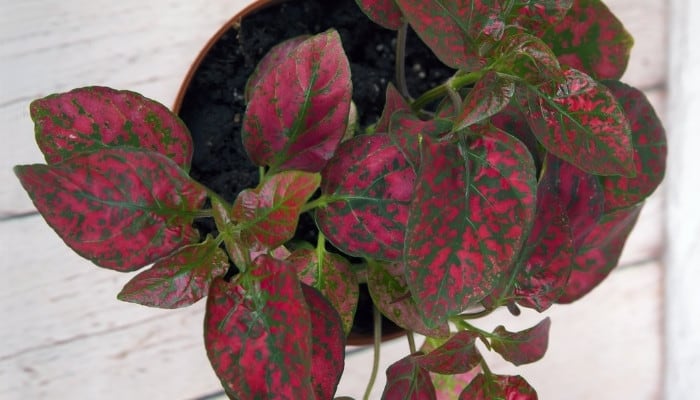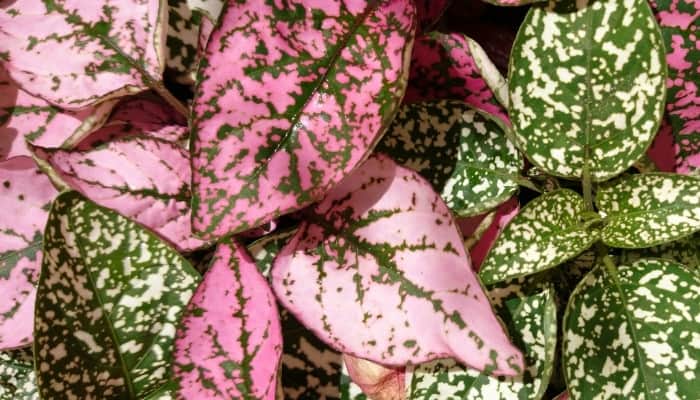The colorful polka dot plant originates from the sunny and warm regions of South Africa, Madagascar, and East Asia.
It is ideally suited as an indoor plant but grows well outdoors in warmer climates. Its colorful foliage comes in a maze of dots and multiple hues that create a stunning focal point in any plant lover’s home.
How long do polka dot plants live? The life cycle of the polka dot plant is typically completed within one year. However, if grown indoors, you may extend its life span by pinching off the flowers as they appear. Propagating new plants using stem cuttings is a great way to ensure you’re never without a polka dot plant indoors.
Although the life span of the polka dot plant is limited, it is easily propagated. In the following, you’ll discover how you can extend your plant’s life with a few simple tips.
Polka Dot Plant Lifespan
The oval leaves of the polka dot plant are variegated and covered in spots of different colors that can range from pink, white, and red to beige and purple. Its flowers are purple and tiny in comparison to the foliage.
Usually, the life span of the polka dot plant is a single year with the plant dying off after it has flowered. However, depending on the growing climate, this plant can display annual or perennial tendencies.
For example, if grown outdoors in USDA Zones 3-10, it displays annual characteristics, dying off at the end of its life cycle. However, if grown indoors, it can survive as a perennial.
Death is often triggered by the plant’s natural life-cycle process of flowering. However, if these flowers are removed, it can extend the polka dot plant’s life.
Pruning ensures the nutrients are sent to the foliage rather than the flowers.
Care Guidelines for Polka Dot Plants

The polka dot plant is also known as the Hypoestes phyllostachya and is commonly called the freckle face plant due to colorful splotchy dots on its green leaves.
Native to the warmer climates of Africa, it prefers moderate temperatures of between 15 and 81℉ (15 – 27℃).
Planting a Polka Dot Plant
The polka dot plant can be grown indoors and outdoors in the warm USDA Zones of 3-10.
Planting Indoor Polka Dot Plants
When bought from the nursery or store, most plants are already rootbound, so repotting is essential.
Select a container that is 1- 2 cm larger than the nursery or store container. Ensure the container has sufficient drainage to allow for excess water to drain away properly.
Add perlite or pumice to increase the draining of general potting soil. Alternatively, use a nutrient-rich potting soil that drains well but is capable of retaining sufficient moisture.
Half fill the container with potting mix, place the plant’s root ball into the soil, and fill the rest of the container with soil.
Place in a warm room away from cold drafts with access to plenty of bright light.
Humidity levels should be kept at approximately 50%, which can be increased with misting or pebble trays (here’s how to make one).
Planting Outdoor Polka Dot Plants
Outdoor polka dot plants love the light but need to be positioned where they are shaded from the direct sun.
Under taller plants or trees and in the shade of your patio or gazebo are excellent options for the outdoor polka dot plant.
Dig a hole large enough to accommodate the root system, place the plant in its new home, and fill in the hole.
This plant enjoys well-draining, moist soil rich in organic matter; use homemade compost to improve your soils nutrient content.
Light Requirements for a Polka Dot Plant
The more light the plant receives, the brighter the foliage freckles will become. However, overexposure to direct sunlight can scorch the leaves.
Place outdoor polka dot plants in the shade of a tree or patio and indoor polka dot plants about 4 feet away from a window to provide adequate light without burning the tender leaves.
Polka Dot Plant Watering & Fertilization
Indoor and outdoor polka dot plants require moist soil to thrive. Check the soil between soakings to ensure the soil does not dehydrate or become overly soggy.
Monitor the polka dot plant for signs of over or underwatering.
Yellow leaves that drop off are a sign of overwatering; reduce your watering schedule. If leaves drop without turning yellow, the plant is dehydrated; increase the watering frequency.
Polka dot plants are always hungry and require regular feeding to keep them healthy. Feed outdoor polka dot plants with a balanced, diluted fertilizer once monthly when actively growing.
Indoor plants will require feeding every other week using the same type of fertilizer. For both indoor and outdoor plants, pour the fertilizer on the soil around the base of the plant.
This fertilizer bundle is ideal as it comes with 1.5 pounds of water-soluble mix for easy diluting and 1 pound of granular food for a slow-release, easy-to-apply option.
Polka Dot Plant Propagation
These plants are easily propagated by seed or cuttings. However, stem cuttings are the most successful and fastest way of growing new polka dot plants.
Propagation by Seed
Collect the dry seed heads from the plant and store them until you are ready to propagate. Then, sow the seeds in a tray of moist peat-based soil. Keep the soil moist during germination.
This can take up to two weeks if temperatures remain between 68 and 77℉ (20-25℃). When the seedlings are strong enough, plant them in partial shade and well-draining soil.
Propagation by Stem Cutting
Propagation using cuttings can be done at any time of the year. Using a sharp pair of scissors or knife, snip off a 2-2.5 inch (5-6 cm) long cutting.
Dip the severed cutting into a little rooting powder 9I’ve always have good results with this one), and place it directly in the soil.
Use clear plastic to cover the plant; this will increase warmth and humidity and promote growth. Plant outdoors or in a new container once the new plant is strong enough.
Note that stem cuttings can also be easily rooted in water. Watch this video to learn how to do it and what to watch for.
6 Tips for Extending the Life of Your Polka Dot Plant
- Pinch off flowers when they develop to encourage leaf growth and delay plant death.
- Prune regularly to promote a bushier appearance and to prevent flowering.
- Fertilize regularly. Feed outdoor plants once monthly and indoor plants every other week.
- Place the plant in dappled light to encourage vibrant and robust foliage development.
- Water regularly, and ensure the soil remains moist but not boggy.
- Avoid chilly temperatures as the plant is not frost resistant.
Polka Dot Plant Varieties
There are many colorful varieties of polka dot plant; check out the list below to choose the one most suited to you.
- Confetti – This smaller variety grows vigorously. The leaf color options range from red, pink, and burgundy to white.
- Pink Splash / Dot – The leaves sport a riot of pink and red splotches against a darker green background.
- Carmina – The foliage is covered in bold red freckles on a deep-green background.
- Pink Brocade – The leaves sport soft mottled pink splashes of color on a green backdrop.
- Purpariana – This plant’s leaves have a deep purple hue.
- White – The white leaves have a unique green spotted pattern.
Related Questions:
How Do I Keep My Polka Dot Plant Bushy?
Use your fingers or a pair of scissors to pinch or snip off the top leaves of each stem regularly. This will encourage bushy, lateral growth rather than leggy growth.
Should I Prune My Polka Dot Plant?
Regular pruning will remove leggy stems and encourage healthy, vigorous growth. Additionally, pruning will also slow the production of flowers that develop when the plant is at the end of its life cycle.
Snipping off the flowers when they appear can help extend the life of your polka dot plant.
Conclusion
The polka dot plant’s striking foliage is perfect for outdoor gardens as filler or ground cover, while indoors, it provides a stunning splash of color for rooms in need of a bright focal point.
Although the polka dot plant may have a relatively short life cycle, you can extend its life by carefully following our compiled tips.

